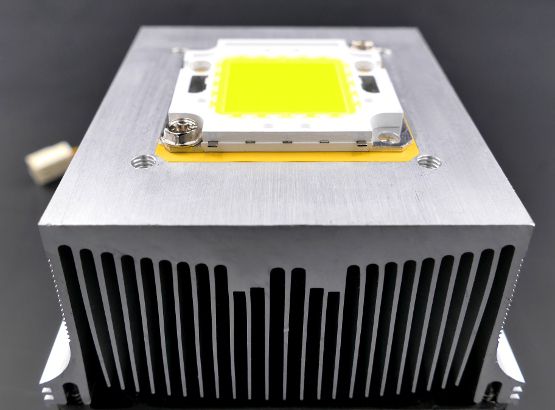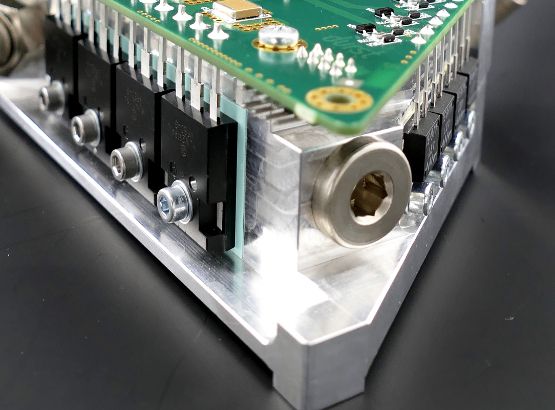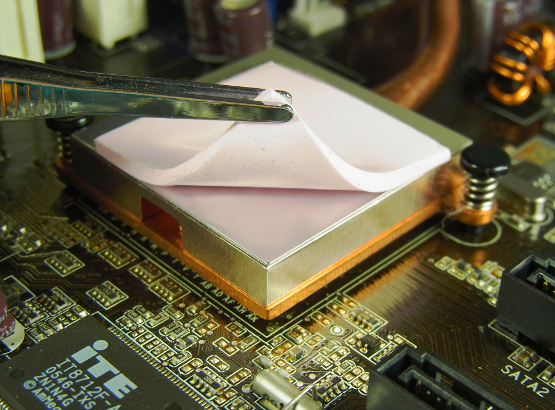Where large electrical currents flow, heat loss inevitably occurs. A rule of thumb for considering the service life of components states that reducing the operating temperature by 10°C doubles the service life. The aim of thermal management is therefore to ensure that the heat loss is dissipated to the environment as effectively as possible. This significantly extends the service life of components and devices.
CMC Klebetechnik offers an extensive range of thermally conductive electrical insulation films / heat conducting materials that also act as galvanic insulation in power electronics. Further information on thermal management, heat transport and thermal conductivity can be found here.
Heat conducting films & adhesive tapes
Filled polyimide film from CMC has excellent tensile strength at low thickness and can withstand high temperatures. The film is elastic and insensitive to punctual loads. It is available as self-adhesive and coated with thermally conductive wax. Kapton® MT is a filled polyimide film.
Also in our product range: the thermally conductive adhesive tapes of the TR series from Nitto.
Graphite and metal films from CMC are electrically and thermally conductive. Graphite films have very good thermal conductivity, but are very sensitive to point loads and bending. Copper or Aluminum films are used as heat spreaders (to dissipate heat from the hotspot). These films can also be coated with adhesive or thermally conductive wax.
Thermally conductive silicone films
Silicone films are thermally conductive insulations in the thickness range from 0.2 mm to 1 mm. They are relatively hard and are particularly suitable as thermally conductive insulation. The filled silicone rubber also adapts very well to rough surfaces under sufficient pressure. This significantly reduces the heat transfer resistance. Different degrees of hardness and material thicknesses allow the silicone film to adapt well to the respective installation situation. Differences in thermal expansion are compensated and vibrations can be dampened.
Gap filler
So-called "gap fillers" are used when the distance between the heat sink and the component becomes large. Gap fillers are available from 1 mm to 10 mm. They are used to compensate for manufacturing tolerances and to connect components of different heights to a common heat sink. Gap fillers are silicone elastomers that are enriched with thermally conductive particles. The thermal conductivity ranges from 1 W/mK to over 6 W/mK. One advantage of the softer gap fillers is the low force exerted on sensitive electronic components (low compression modulus). Gap fillers are usually slightly adhesive and wet surfaces in an ideal way (reduction of heat transfer resistance). Due to their viscoelastic behavior, they can also be used as vibration dampers.
FAQ
The specific thermal conductivity value (in W/m*K) is a material constant that indicates how well (or poorly) the product conducts the heat flow, regardless of the mechanical dimensions (surface area, thickness).
The thermal resistance, on the other hand, indicates the resistance of the material (the arrangement) to the heat flow in a specific structure with surface area and material thickness.
The relevant variables are firstly the material thickness and the specific thermal conductivity of the thermally conductive insulation material. Then there is the effective transfer area (the cross-section for the heat flow) and - not to be underestimated - the resistances at the transitions.
If all other parameters such as material thickness and cross-sectional area are the same, the contact resistances play a significant role in the differences. On the one hand, soft thermally conductive products can be pressed together better than harder ones, e.g. silicone films. This also brings the distance between the thermally conductive additives in the polymer matrix closer together, which improves heat conduction. Above all, however, the positive fit to the contact surfaces is better with softer products than with hard ones. This difference decreases with increasing pressure.
The adaptation to surface irregularities is better with softer products than with rigid thermally conductive insulations such as Kapton® MT. The use of softer materials also prevents excessive mechanical stress on a component or circuit board, as the form fit and therefore optimum heat conduction is achieved earlier.
The distance that the heat flow has to overcome through the material is directly included in the calculation of the thermal resistance. An illustrative example of the influence of material thickness: tent wall or castle wall, where does the heat pass through faster?
Thin films usually have very good dielectric strength. Although the specific thermal conductivity value is low, they have a relatively low thermal resistance due to the low material thickness. Films can be used to create very compact, reliable thermally conductive insulation (disadvantage: surface roughness, dimensional tolerances etc. cannot be compensated)
In addition to the material-specific thermal resistance (1/conductance), the contact resistances are often an essential component of the thermal conduction path. Dimensional tolerances, deformation or surface roughness can lead to a discrepancy between the metal surfaces to be joined. These "gaps and cavities" are compensated for by soft, thermally conductive products. The disadvantage here is the variable material thickness, e.g. with asymmetrical fastening. The reduced thickness on one side due to crushing is synonymous with a reduction in dielectric strength.
The temperature difference resulting from an electrically insulating, thermally conductive material at a given power (heat flow) is calculated as follows:
dT = P x l/(λ x A)
In the formula, P is the power loss, l is the thickness of the material, λ is the specific thermal conductivity, dT is the temperature difference and A is the contact area.
Example: P = 100 W, l = 0.2 mm, λ = 5 W/mK, A= 10000 mm² (10x10 cm) The resulting temperature difference dT is 0.4 K.
Important: Heat transfer resistances are not taken into account in this calculation.
λ =P x l /(dT x A)
In the formula, P is the power loss, l is the thickness of the material, λ is the specific thermal conductivity, dT is the temperature difference and A is the contact area.
Example: to limit the temperature difference at 100W power loss to 2 degrees for a 25 cm x 10 cm surface and 0.5 mm thickness, you need a material with a specific conductance of 1 W/mK
Important: Heat transfer resistances are not taken into account in this calculation.
Areas of application for heat conducting materials
Thermal management is an important topic for LED applications, industrial PCs, solar converters, motor drives, high-frequency power supplies, super caps, high-performance capacitors, battery technology, power grids, information technology, power electronics and automotive applications (HEV, OBC, DC/DC converters).
Thermally conductive products / thermally conductive materials from CMC are manufactured to customer specifications for the following applications:
IT technology: WLAN routers, servers, notebooks, VOIP telephones, memory modules, hard disks and printers
Power supply: Inverters, power converters, grid components (smart grid), uninterruptible power supplies, DC/DC inverters, solar inverters, motor control units
Automotive technology: daytime running lights, brake lights (LED strip), electronics for power steering, ABS brake modules, car electronics, power semiconductors
Home and lighting technology: power LED lamps, smart meters, audio devices, LCD televisions
as well as in medical technology and in the construction of electric motors and generators.


